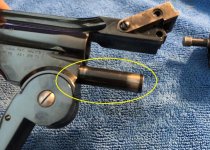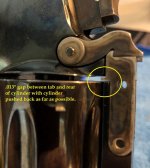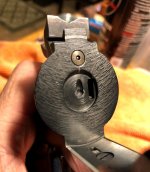Hearsedriver
Member
You still have not mentioned what you have been shooting in the gun?
As mentioned, HSM Cowboy loads. I use factory cowboy action ammo, usually 200-230 grain traveling at between 700-800 fps. No reloads.
The latch on the Schofield was designed to take what 45 caliber ammo could offer in the day. The latch would have to travel over 1/8" before the gun could open and then there is no way it would be able to re-latch on its own.
I too have been thinking that there is a chance of a bent frame, but solid lock-up would indicate that has not happened?? My theory is that the base pin is too short, since nothing else can prevent the cylinder from traveling rearward. Perhaps a gunsmith could add length by building up a weld on the stud and shaping it until the cylinder locks solidly without enough play in the cylinder to allow it to contact the cylinder catch tabs. Shims will do nothing to prevent the damage you are seeing since they will not stop rearward movement of the cylinder.
Agreed. I wish I knew how to remove the base pin from the frame. I dont know if it is threaded or pressed in.
Lastly, .007" sounds way to small?? With the action open, pull the cylinder back as far as possible and measure the gap.
.028"
Now close the gun and pull the cylinder back and measure.
.015"
You can figure out what you have with feeler gauges in front of the cylinder. Using my reproduction Schofield as an example, i measured the gap between the barrel and face of the cylinder when the rear of the cylinder was touching the catch tabs and it was .015" Closing the gun and pushing the cylinder as far rearward as possible, I got .009". That tells me that the recoil shield is holding the cylinder .006" away from the tabs and therefore no damage to the cylinder. Check your out with careful measurements. Snug fit with the gauges, but not forced is the key.
So mines comes out to .013" vs. your .006". Wow! Kinda sounds like I have a stretched frame.
To be clear, you are calling the part I have circled the base pin, correct?
What am I missing? Here is a picture of the gap which seems more then enough between the cylinder and tab.
As mentioned, HSM Cowboy loads. I use factory cowboy action ammo, usually 200-230 grain traveling at between 700-800 fps. No reloads.
The latch on the Schofield was designed to take what 45 caliber ammo could offer in the day. The latch would have to travel over 1/8" before the gun could open and then there is no way it would be able to re-latch on its own.
I too have been thinking that there is a chance of a bent frame, but solid lock-up would indicate that has not happened?? My theory is that the base pin is too short, since nothing else can prevent the cylinder from traveling rearward. Perhaps a gunsmith could add length by building up a weld on the stud and shaping it until the cylinder locks solidly without enough play in the cylinder to allow it to contact the cylinder catch tabs. Shims will do nothing to prevent the damage you are seeing since they will not stop rearward movement of the cylinder.
Agreed. I wish I knew how to remove the base pin from the frame. I dont know if it is threaded or pressed in.
Lastly, .007" sounds way to small?? With the action open, pull the cylinder back as far as possible and measure the gap.
.028"
Now close the gun and pull the cylinder back and measure.
.015"
You can figure out what you have with feeler gauges in front of the cylinder. Using my reproduction Schofield as an example, i measured the gap between the barrel and face of the cylinder when the rear of the cylinder was touching the catch tabs and it was .015" Closing the gun and pushing the cylinder as far rearward as possible, I got .009". That tells me that the recoil shield is holding the cylinder .006" away from the tabs and therefore no damage to the cylinder. Check your out with careful measurements. Snug fit with the gauges, but not forced is the key.
So mines comes out to .013" vs. your .006". Wow! Kinda sounds like I have a stretched frame.
To be clear, you are calling the part I have circled the base pin, correct?
What am I missing? Here is a picture of the gap which seems more then enough between the cylinder and tab.
Attachments
Last edited:



